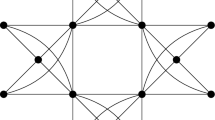Abstract
Special number sequences play important role in many areas of science. One of them named as Fibonacci sequence dates back to 820 years ago. There is a lot of research on Fibonacci numbers due to their relation with the golden ratio and also due to many applications in Chemistry, Physics, Biology, Anthropology, Social Sciences, Architecture, Anatomy, Finance, etc. A slight variant of the Fibonacci sequence was obtained in the eighteenth century by Lucas and therefore named as Lucas sequence. There are very natural close relations between graph theory and other areas of Mathematics including number theory. Recently Fibonacci graphs have been introduced as graphs having consecutive Fibonacci numbers as vertex degrees. In that paper, graph theory was connected with number theory by means of a new graph invariant called \(\varOmega (D)\) for a realizable degree sequence D defined recently. \(\varOmega (D)\) gives information on the realizability, number of components, chords, loops, pendant edges, faces, bridges, connectedness, cyclicness, etc. of the realizations of D and is shown to have several applications in graph theory. In this paper, we define Lucas graphs as graphs having degree sequence consisting of n consecutive Lucas numbers and by using \(\varOmega \) and its properties, we obtain a characterization of these graphs. We state the necessary and sufficient conditions for the realizability of a given set D consisting of n successive Lucas numbers for every n and also list all possible realizations called Lucas graphs for \(1 \le n \le 4\) and afterwards give the general result for \(n \ge 5\).


















Similar content being viewed by others
References
Bondy, J.A., Murty, U.S.R.: Graph Theory. Springer, New York (2008)
Delen, S., Cangul, I.N.: A new graph invariant. Turk. J. Anal. Number Theory 6(1), 30–33 (2018)
Delen, S., Cangul, I.N.: Extremal problems on components and loops in graphs. Acta Math. Sinica Eng. Ser. 35(2), 161–171 (2019)
Delen, S., Togan, M., Yurttas, A., Ana, U., Cangul, I.N.: The effect of edge and vertex deletion on omega invariant. Appl. Anal. Discrete Math. 14, 1–11 (2020)
Delen, S., Yurttas, A., Togan, M., Cangul, I.N.: Omega invariant of graphs and cyclicness. Appl. Sci. 21, 91–95 (2019)
Demirci, M., Akbayrak, O., Ozbek, A., Cangul, I.N.: Fibonacci Graphs (Preprint)
Diestel, R.: Graph Theory. Springer GTM, New York (2010)
Foulds, L.R.: Graph Theory Applications. Springer Universitext, Berlin (1992)
Lucas, E.: Recherces sur Plusieurs Ouvrages de Leonard de Pise et sur Diverses Questions d’Arithmetique Superieure. Imprimerie des Sciences Mathematiques et Physiques, Rome 10(129–193), 239–293 (1877)
Sanli, U., Celik, F., Delen, S., Cangul, I.N.: Connectedness Criteria for Graphs by Means of Omega Invariant. FILOMAT 34 (2020) (Preprint)
Wallis, W.D.: A Beginner’s Guide to Graph Theory. Birkhauser, Boston (2007)
Author information
Authors and Affiliations
Corresponding author
Ethics declarations
Conflicts of interest
There is no conflict of interest between the authors or with anybody else.
Additional information
Publisher's Note
Springer Nature remains neutral with regard to jurisdictional claims in published maps and institutional affiliations.
Rights and permissions
About this article
Cite this article
Demirci, M., Ozbek, A., Akbayrak, O. et al. Lucas graphs. J. Appl. Math. Comput. 65, 93–106 (2021). https://doi.org/10.1007/s12190-020-01382-z
Received:
Revised:
Accepted:
Published:
Issue Date:
DOI: https://doi.org/10.1007/s12190-020-01382-z




